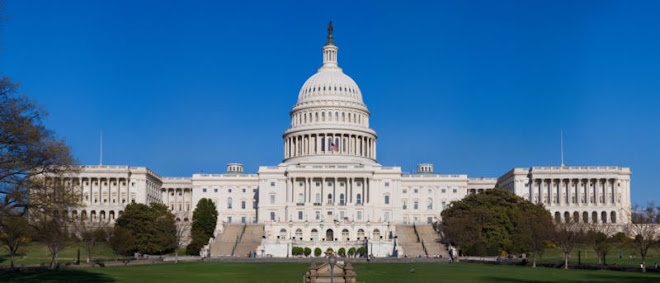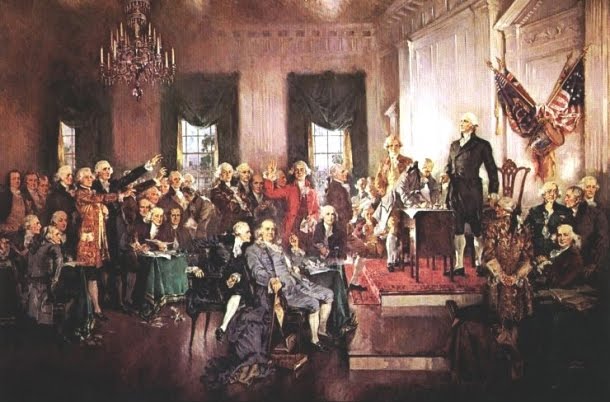From Campaign for Liberty:
Crisis and Leviathan: Observations amid the Current Episode
By Robert Higgs
Published 05/21/10
Printer-friendly version
Since the early twentieth century, periods of real or perceived national emergency have been "critical episodes" in the growth of government's size, scope, and power in the United States and in many other countries. Hence, the concise conceptualization: Crisis and Leviathan (the main title of my 1987 book on the growth of government in the United States from the late nineteenth century to the late twentieth century).
In the past century, the first five such critical episodes in the United States were: World War I; the Great Depression; World War II; a multi-faceted set of crises associated with the civil-rights revolution and the Vietnam War, roughly coincident with the presidencies of Lyndon B. Johnson and Richard M. Nixon; and the post 9/11 events associated with the so-called War on Terror and the U.S. attacks on and occupations of Afghanistan and Iraq. We are now amid another such critical episode, which springs from the housing bust that began in 2006, the economic recession that began late in 2007, and the financial debacle that reached its climax in September 2008.
The current troubles are complex and raise a multitude of questions. Many books and articles no doubt will be written to analyze these various issues in scholarly depth and detail, and certainly anything we might say today must be regarded as preliminary, at best. I focus here on a few aspects of the present episode that relate closely to my own research on the growth of government, a field of study to which I have returned again and again over the past thirty years.
I
The current recession has elicited many comparisons with earlier business downturns, especially with the Great Depression. Federal Reserve chairman Ben Bernanke is often described as an expert on the Great Depression who takes its lessons, as he understands them, deeply into account as he formulates and implements Fed policies. Likewise, many other economists have revisited the Great Depression recently in search of lessons applicable to current policy-making. In all of these reflections, the mainstream economics profession in general has distinguished itself by an astonishing superficiality of historical knowledge and lack of theoretical prowess.
The swiftness with which a great many mainstream economists have reverted to the simplistic "vulgar Keynesianism" that had its heyday from the late 1940s to the late 1960s has been nothing short of shocking, given that by the end of the 1970s such old-fashioned Keynesianism seemed to have been completely discredited and superseded in the leading echelons of the mainstream economics profession. Now it has come roaring back. Of course, the general public, whose understanding of such matters is always primitive, and the politicians, who are always looking for plausible intellectual rationales to excuse their insatiable spending, borrowing, and power-grabbing, had never abandoned vulgar Keynesianism, so they were elated to find that the economic "experts" were again confirming their own self-interested inclinations.
From such vulgar Keynesian thinking flowed the succession of "stimulus" spending measures, beginning with the Bush administration’s, carried out in the spring of 2008. Other governments have gone down the same foolish path. Of course, as any competent economist could have testified even fifty years ago, such temporary government-spending surges give people money that, for the most part, they save or use to pay off debts, rather than spending it along the lines envisioned by Keynesian "multiplier" analysis to set in motion an upward spiral of income, expenditure, real output, and employment. Much of the so-called stimulus spending in the United States has served only to bulk up the pay and benefits of government employees (federal, state, and local), effectively transferring income from the private sector to the government sector, and to reward other groups, such as the United Auto Workers and low-income home buyers, for their support of the Obama administration -- past, present, or future.
At the same time, Bernanke and other central bankers, obsessed by an irrational fear of deflation, set in motion liquidity-enhancing measures so vast that no one could reasonably have anticipated them. Excess reserves of depository institutions in the United States now substantially exceed $1 trillion, as the banks have simply absorbed the effusions of dollars the Fed has spent to acquire an unprecedented variety of "securities," including various "toxic" assets that Fannie Mae, Freddie Mac, and other ill-managed firms had acquired during the housing boom and later.
Bernanke and his colleagues in other central banks are taking credit for saving the financial system and even for saving the world from a repetition of the Great Depression -- claims that must be treated with extreme skepticism. In any event, however, they have certainly created the potential for rapidly accelerating consumer-price inflation, should the banks become less apprehensive about their balance sheets and employ their vast excess-reserve balances to resume their lending and investing on a more normal basis.
Bernanke expresses confidence that he has the "tools" to rein in such potentially inflationary bank action, mainly by raising the interest rate the Fed pays banks on their deposits at the Fed, but one may well doubt whether he will be able to use those tools effectively. When interest rates begin to rise substantially, as they must sooner or later, great political pressure will be brought against tighter-money actions by the Fed and other central banks; the politicians will protest increases in interest rates at a time when unemployment remains at an elevated rate and other aspects of the recession linger, as well. So, even if Bernanke has the effective tools he claims to have, the question remains as to whether he will have the personal courage and the political support required to use those tools effectively.
II
One aspect of the current crisis that has come as anything but a surprise is that the politicians and their supporting coalition of crony capitalists and other backers have certainly not (in the immortal words of Barack Obama's chief of staff Rahm Emanuel) allowed "a crisis to go to waste." The past two years have witnessed one power-grab or institutional takeover after another, most notably of AIG, Fannie, Freddie, General Motors, and Chrysler. Under the TARP scheme, the Treasury has taken ownership positions in hundreds of large banks by acquiring preferred shares and warrants. Virtually all residential mortgage lending now ultimately springs from the secondary market and guarantees provided by Fannie, Freddie, Ginnie Mae, FHA, and VA. This aspect of the government's power-grab has been especially important because by continuing to pump funds into dodgy mortgages, the government is preventing the necessary restructuring of the housing-construction industry and the mortgage-credit sector, propping up unqualified and underwater borrowers and ill-managed and even insolvent lenders, and thereby creating great potential for a second round of the housing/housing-finance bust in the near-term future.
As the huge recent expansion of the government's size and scope has proceeded, the Treasury's fiscal condition has deteriorated badly. The federal deficit jumped from an amount equal to about 3 percent of GDP in fiscal 2008 to an amount equal to about 10 percent of GDP in fiscal 2009, and even the government's forecasts now project deficits in the neighborhood of $1 trillion per year for the next decade. Thus, the U.S. government's debt has exploded, and will continue to rise relentlessly -- or, it will do so as long as willing buyers can be found for bonds promising only modest nominal yields, a market that Uncle Sam can no longer assume will persist indefinitely. (The Chinese and other major buyers are already grousing and insisting that the U.S. Treasury act more prudently.)
While the government proper was expanding its size, scope, and power, the Fed was greatly expanding the magnitude and scope of its own balance sheet and, in effect, engaging in "industrial policy" by singling out particular firms and industries for assistance, while steering clear of others in equally dire condition. If the Fed is not "picking winners," it is certainly deciding who will be spared a market-determined fate as a loser. Fed officials insist that they intend to withdraw from many of the new areas they have recently entered, once the crisis has passed, but it will be surprising if the recent "emergency" policies do not remain in the Fed's arsenal, bulking up its power, and equally surprising if it sloughs off all of the unusual types of "securities" it has acquired in the past two years.
At the moment, the Fed is seeking -- and it, the FDIC, or another government regulatory entity may well be given -- wide-ranging statutory authority to reorganize preemptively any seemingly failing firm (not only banks) whose failure would pose, in the Fed's estimation, a "systemic risk." Such authority would greatly expand the Fed's current power as a monetary central planner by adding a role as risk-management central planner. Regardless of whether the Fed, the FDIC, or another government regulatory entity ends up the winner of the current power scramble, the possible repercussions of this expanded power on the operation of the capital markets is frightful to contemplate.
III
As the current troubles have led many economists and others to revisit the government's policies during the 1930s, some have concluded that even though the New Deal's hodgepodge of policies never brought about full recovery, the action that most economists believe did effect a full recovery -- in Paul Krugman's words, "the large public works program, otherwise known as World War II, that ended the Great Depression" -- suggests a remedy for today's recession along similar lines. In retrospect, it is clear that this belief in the creation of "wartime prosperity" by massive government spending and deficit financing did more than anything else to bring about acceptance of the Keynesian paradigm in the 1940s and 1950s. Even today, not only the general public but most professional economists remain firmly convinced that, as the familiar saying maintains, "the war got the economy out of the Great Depression," and hence a serious recession such as the present one naturally causes them to recall this supposed "lesson" of economic history. Among many lesser lights, Martin Feldstein, one of the country's most eminent and influential economists, has recently proposed what amounts to an exercise in military Keynesianism as a stimulus measure.
The fly in this ointment, however, is that the lesson almost everyone has drawn from the events of the 1940s is false; the common belief is a myth. When we take apart the simplistic Keynesian analysis of the war's effect on the economy and look carefully at what actually happened to the various components of the labor force, the capital stock, and the gross domestic product, we see that the economic events of the war years represent a classic case of a command economy's sacrificing butter -- not to mention life, liberty, and property -- for the sake of producing and deploying more guns.
A single graph suffices to give us a more accurate portrayal of the economy's performance in the 1930s and 1940s (for a complete analysis, see the first five chapters of my 2006 book Depression, War, and Cold War).
Source: Originally published in my 1999 article in the Journal of Economic History
As the graph shows, real GDP dropped sharply in the early 1930s, then recovered rapidly after 1933, but it did not reach its high-employment growth trend until 1941, when the nature of the economy's output (shifting rapidly into war production) was beginning to obscure the meaning of data that purport to measure "real output." If we accept the standard data, a huge war boom appears to have occurred during the war years, followed by a sharp downturn, concentrated in 1946, after which the economy moved closely along its high-employment growth trend (shown in the figure by the straight line connecting the [logarithms of the] values for 1929 and 1948).
Looking at the private part of GDP -- the part with a much clearer meaning, owing to its derivation from freely-made consumer and investor choices about the use of privately owned funds -- we see a similar pattern during the 1930s, but a completely different pattern during the 1940s. After 1941, private output of both consumer and investor goods fell to much lower levels and remained submerged far below the high-employment growth trend throughout the war years. Private real output did not exceed its 1941 rate until 1946, when it shot up by about 30 percent in a single year. Afterward, the private economy moved closely along its high-employment growth trend. Real prosperity had been achieved at last, for the first time since 1929.
But wait, the critics protest: didn't the war wipe out mass unemployment? Of course, it did. However, this elimination of mass unemployment had nothing to do with Keynesian fiscal policy (or, for that matter, with the concurrent, highly expansive monetary policy) and everything to do with the military draft, which pulled the equivalent of 22 percent of the prewar labor force into the armed forces. If the economy has 5--7 million persons unemployed, then drafting 10 million prime-age workers (and thereby inducing millions of others to enlist "voluntarily") will "solve" the unemployment problem every time. To use the same policy today, the U.S. authorities need only to conscript about 30 million men -- not, I daresay, a political idea whose time has come.
Indeed, the idea is preposterous, and so, more generally, is looking to the government's alleged "large public works program, otherwise known as World War II" as a model of how to deal with today's economic crisis. Rather than allow ourselves to be mesmerized by a statistically spurious bulge of real GDP during World War II, we are better advised to recall the wartime rationing of many ordinary consumer goods, the shortages or complete production closures of many consumer goods (e.g., automobiles, most consumer durables), the preemption of public transport by the military authorities, and the wage, price, and rent controls that caused, among many other undesirable consequences, drastic deterioration in the quality of many goods and services. Whatever else the war might have accomplished, it certainly did not produce conditions that we may properly describe as genuine prosperity.
IV
Even if policy makers decline to adopt World War II-type policies as remedies for the current recession, the immense magnitude of the present-day military-industrial complex certainly complicates all efforts to effect a recovery, by draining more than $1 trillion a year from the economy's potential to produce private consumer and producer goods. The current long-running wars and military occupations in Afghanistan and Iraq, which will probably never end, although eventually they may be scaled back somewhat, only add to the economic drain on U.S. resources. So far, more than $1 trillion has been expended for these ill-fated adventures, and their total cost may eventually cumulate to several times this amount, not simply because they, like the U.S. military presence in Japan, Korea, and various European countries, will continue indefinitely, but also because of the need to care for a multitude of physically and psychologically disabled veterans over a span of several decades.
Even if the wars in the Middle East were concluded overnight, however, a huge distortion would continue to affect the U.S. economy, owing to the normal operation of the military-industrial complex and the maintenance of the current armed forces and their far-flung empire of more than 800 large overseas bases. This military hypertrophy reflects not an attempt to pump up the macroeconomy, as military Keynesians would have it, but rather the devotion of U.S. ruling elites to the maintenance of global military hegemony, ultimately capped by the attainment of "full-spectrum dominance" -- "control of land, sea, air and space and all attendant resources" over the entire world.
Why do U.S. policy makers seek such god-like control of the planet? To the extent that the military leadership itself contributes to shaping national-security policies, this o'erleaping ambition merely expresses the latest phase of the military's longstanding maniacal quest for total power -- the undoubted ability to win any and all conceivable wars. Among the civilian leadership, the motives range more widely. An important impulse, though it is never mentioned frankly in polite company, is to maintain a foreign military presence configured so as to make the state of Israel as secure as possible. Another abiding interest is to control the worldwide distribution of petroleum, if necessary by bribing, intimidating, or taking military action against the governments of important oil-producing countries, especially in the Persian Gulf region.
Related to this wholly unnecessary quest to control the world's oil-distribution channels -- after all, it does not serve the interests of the oil producers to withhold their product from the world market -- is the ambition to play the Great Game by throwing up barriers to the expanding influence of China and India and the residual potential of Russia in southwest Asia, especially in the Caspian Sea region, where vast stores of oil and gas remain to be tapped and brought to market. For more than half a century, U.S. leaders have been obsessed with projecting their country's power into petro-military adventures of all sorts. However senseless this fixation might seem in a purely economic perspective, we can scarcely deny that the coziest crony capitalists in the oil and related industries have reaped a great deal of income along the way, and owing to their extraordinary political clout, they have every expectation of continuing to reap such income in the future, with the vital assistance of U.S. diplomats and armed forces to grease the skids.
Although the military-industrial-congressional complex is one of the most powerful interest groups in U.S. politics, and we may certainly expect it to struggle forcefully to retain or even to increase the flow of wealth placed at its disposal, the U.S. government's increasingly precarious financial condition may compel even this powerful coalition to settle for a smaller space at the trough, especially if stagflation sets in as the U.S. economy's normal condition during the next decade (as I suspect it will). If America's economic future turns out to be even worse than I now foresee -- for example, with rapid inflation, price and capital controls, and a flight from the dollar -- then even greater retrenchment of the U.S. military presence abroad will be unavoidable. Such economic ruin would be a heavy price to pay for reining in America's global hegemony, but, nevertheless, the military retrenchment itself would be a consequence that most of the world's people would celebrate.
Acknowledgment: This commentary was originally prepared for presentation at a meeting convened by Diapason Commodities Management S.A. in Venice, Italy, April 30, 2010. I am grateful to Sean Corrigan and his colleagues at Diapason for inviting me to speak at this meeting.
Copyright © 2010 by LewRockwell.com. Permission to reprint in whole or in part is gladly granted, provided full credit is given.
A READER ON THE STATE OF THE POLITICAL DECAY AND IDEOLOGICAL GRIDLOCK BETWEEN ONE GROUP WHO SEEK TO DESTROY THE COUNTRY, AND THOSE WHO WANT TO RESTORE IT.
The Rise and Fall of Hope and Change




Alexis de Toqueville
The American Republic will endure until the day Congress discovers that it can bribe the public with the public's money.
Alexis de Tocqueville
Alexis de Tocqueville
The United States Capitol Building

The Constitutional Convention

The Continental Congress

George Washington at Valley Forge





No comments:
Post a Comment